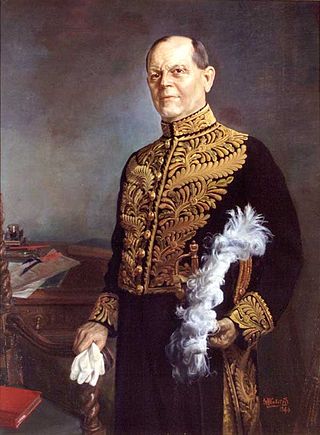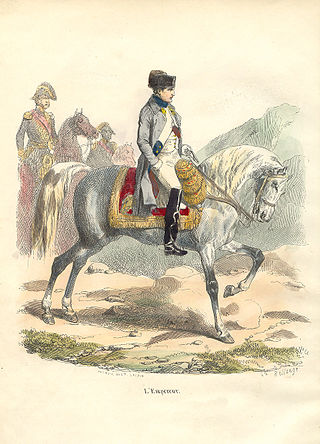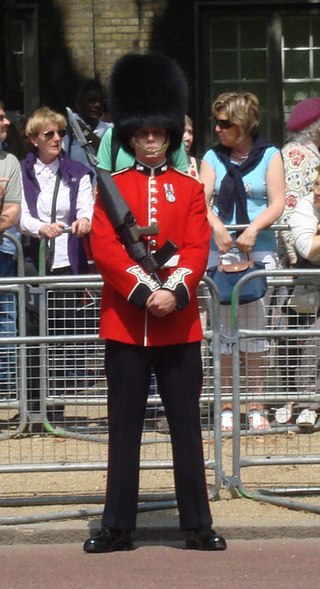

A shell jacket is a garment used as part of a military uniform. [1] It is a short jacket that reaches down to hip level. [2] It was very common in the mid and late 19th century. The jacket was first created in Austria.


A shell jacket is a garment used as part of a military uniform. [1] It is a short jacket that reaches down to hip level. [2] It was very common in the mid and late 19th century. The jacket was first created in Austria.
The shell jacket was first introduced to European armies toward the end of the 18th Century. Prior to this, European soldiers, infantry, cavalry and artillery had worn open dress uniform coats with turn-back lapels over either coloured or white sleeved-waistcoats and breeches. The advent of closed uniform coatees, i.e. waist- length jackets with standing collars and tails, buttoned from throat to waist, meant that sleeved waistcoats could not be worn underneath and therefore fell redundant. However, in order to save damage or staining to dress coatees while on fatigue duties, etc., a new, relatively plain coloured waist-length jacket was introduced. The term “shell” jacket is of British origin, appearing during the 1790s, when light dragoons adopted a dark blue short jacket with a decorative sleeveless over-jacket or “shell” on top. Though short-lived, the name stuck and was later to be applied to waist-length, sleeved fatigue jackets from about 1800. During the first half of the 19th Century, the British Army wore dress coatees in battle against Europeans or Americans, but tended to wear shell jackets on colonial campaigns. However, the shell jacket was discontinued by the British in the 1870s (other than by certain cavalry regiments) in favour of a second, plainer skirted tunic. Guards and Highland regiments continued to wear white shell jackets for “walking out” until 1914.
The shell jacket became regulation for the US army in 1833, replacing the Napoleonic-era blue tailcoat. Infantry jackets were sky blue with white piping and silver buttons. Cavalry uniforms were navy blue with orange (later yellow) piping and artillery uniforms were identical but with red piping; they had brass rather than silver buttons. The infantry uniform was worn during the Mexican War until 1851 when it was replaced with the dark blue frock coat with sky blue piping. Trousers with a fly front replaced the older-style flap-front design and kepis and Hardee hats replaced the M1839 wheel cap. Cavalry and artillery shell jackets remained in use until after the American Civil War as they were more practical for mounted troops than the long frock (which was briefly introduced in 1851 but rejected).
The Confederate States of America adopted the jacket in 1861; the most famous are the Richmond Depot's, RDI, RDII, and RDIII. Columbus Depot, Department of Alabama, and Atlanta Depot also were common famous suppliers. See uniforms of the Confederate States military forces for more information.
During World War II, Dwight D. Eisenhower popularised a waist-length jacket based on British Battle Dress. This was known as an Ike Jacket and after the war was adopted as a uniform by many US police forces. Blue denim versions became popular among urban workers, cowboys, truck drivers and teenagers. Today these jackets (often with patches, studs and badges added) are popular among bikers, greasers, metalheads and punks. In addition it plays a minor role in mainstream European fashion.
A tailcoat is a knee-length coat characterised by a rear section of the skirt, known as the tails, with the front of the skirt cut away.

The kepi is a cap with a flat circular top and a peak, or visor. In English, the term is a loanword of French: képi, itself a re-spelled version of the Alemannic German: Käppi, a diminutive form of Kappe, meaning "cap". In Europe, this headgear is most commonly associated with French military and police uniforms, though versions of it were widely worn by other armies during the late 19th and early 20th centuries. In North America, it is usually associated with the American Civil War, as it was worn by soldiers on both sides of the conflict.

A military uniform is a standardised dress worn by members of the armed forces and paramilitaries of various nations.

Mess dress uniform is the most formal type of uniforms used by military personnel, police personnel, and other uniformed services members. It frequently consists of a mess jacket, trousers, white dress shirt and a black bow tie, along with orders and medals insignia. Design may depend on regiment or service branch, e.g. army, navy, air force, marines, etc. In Western dress codes, mess dress uniform is the supplementary alternative equivalent to the civilian black tie for evening wear or black lounge suit for day wear although military uniforms are the same for day and evening wear. Mess dress uniforms are typically less formal than full dress uniform, but more formal than service dress uniform.

A frock coat is a formal men's coat characterised by a knee-length skirt cut all around the base just above the knee, popular during the Victorian and Edwardian periods (1830s–1910s). It is a fitted, long-sleeved coat with a centre vent at the back and some features unusual in post-Victorian dress. These include the reverse collar and lapels, where the outer edge of the lapel is often cut from a separate piece of cloth from the main body and also a high degree of waist suppression around the waistcoat, where the coat's diameter round the waist is less than round the chest. This is achieved by a high horizontal waist seam with side bodies, which are extra panels of fabric above the waist used to pull in the naturally cylindrical drape. As was usual with all coats in the 19th century, shoulder padding was rare or minimal.

Imperial Japanese Army uniforms tended to reflect the uniforms of those countries who were the principal advisors to the Imperial Japanese Army at the time.

Full dress uniform, also known as a ceremonial dress uniform or parade dress uniform, is the most formal type of uniforms used by military, police, fire and other public uniformed services for official parades, ceremonies, and receptions, including private ones such as marriages and funerals. Full dress uniforms typically include full-size orders and medals insignia. Styles tend to trace back to uniforms used during the 19th century, although the 20th century saw the adoption of mess dress-styled full-dress uniforms. Designs may depend on regiment or service branch. In Western dress codes, full dress uniform is a permitted supplementary alternative equivalent to the civilian white tie for evening wear or morning dress for day wear – sometimes collectively called full dress – although military uniforms are the same for day and evening wear. As such, full dress uniform is the most formal uniform, followed by the mess dress uniform.
The United States Army in World War II used a variety of standard and non-standard dress and battle uniforms, which often changed depending upon the theater of war, climatic environment, and supply exigencies.

Court uniform and dress were required to be worn by those in attendance at the royal court in the 19th and early 20th centuries.
The ranks and insignia of the Confederate States were a rank insignia system devised for the Military of the Confederate States of America during the American Civil War.

The uniforms of La Grande Armée, the army of Napoleon I, are described in this article.

The uniforms of the British Army currently exist in twelve categories ranging from ceremonial uniforms to combat dress. Uniforms in the British Army are specific to the regiment to which a soldier belongs. Full dress presents the most differentiation between units, and there are fewer regimental distinctions between ceremonial dress, service dress, barrack dress and combat dress, though a level of regimental distinction runs throughout.

The Eisenhower jacket or "Ike" jacket, officially known as the Jacket, Field, Wool, Olive Drab, is a type of waist-length jacket developed for the U.S. Army during the later stages of World War II and named after Dwight D. Eisenhower. Intended to be worn on its own or as an insulating layer beneath the M-1943 Field Jacket and over the standard wool flannel shirt and wool sweater, it featured a pleated back, adjustable waist band, fly-front buttons, bellows chest pockets, slash side pockets, and shoulder straps.

The United States Marine Corps (USMC) prescribes several types of military uniform to distinguish its service members from other armed services, depending on the situation.
The uniforms of the United States Army distinguish soldiers from other service members. U.S. Army uniform designs have historically been influenced by British and French military traditions, as well as contemporary U.S. civilian fashion trends. The two primary uniforms of the modern U.S. Army are the Army Combat Uniform, used in operational environments, and the Army Green Service Uniform worn during everyday professional wear and during formal and ceremonial occasions that do not warrant the wear of the more formal blue service uniform.
The military uniforms of the Union Army in the American Civil War were widely varied and, due to limitations on supply of wool and other materials, based on availability and cost of materials. The ideal uniform was prescribed as a dark blue coat with lighter pants, with a black hat. Officer's ranks were denoted with increasing levels of golden decoration. Specific jobs, companies, and units had markedly different styles at times, often following European customs such as that of the Zouaves. Officers uniforms tended to be highly customized and would stray from Army standard. Ironically, several main pieces of gear had been created by order of Confederate president Jefferson Davis before the war, when he was United States Secretary of War.

Each branch of the Confederate States armed forces had their own service dress and fatigue uniforms and regulations regarding them during the American Civil War, which lasted from April 12, 1861, until May 1865.

A coatee was a type of tight fitting uniform coat or jacket, which was waist length at the front and had short tails behind. The coatee began to replace the long tail coat in western armies at the end of the eighteenth century, but was itself superseded by the tunic in the mid nineteenth century.

A military tunic is a type of medium length coat or jacket, the lower hem of which reaches down to the thighs all the way round. It is named after the tunic, a garment of similar length worn in Ancient Rome.
British Army mess dress is the formal military evening dress worn by British Army officers and senior non-commissioned officers in their respective messes or at other formal occasions.
Shell jacket.